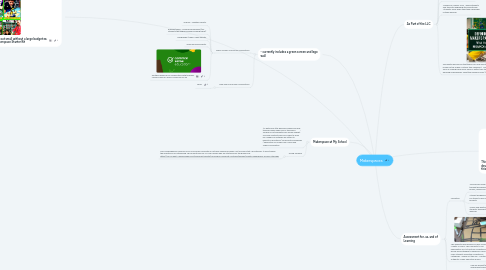
1. This website offers great ideas for starting out small without a large budget ex. duct tape station and origami centre - Makerspace Starter Kit
2. - currently includes a green screen and lego wall
2.1. Green Screen Curriculum connections
2.1.1. Science - weather reports
2.1.2. English/Media - commercial parodies (my students thoroughly enjoyed making these)
2.1.3. Geography /Media -news reports
2.1.4. -video announcements
2.1.5. Another resource for collaboration with teachers Lesson Plans for Green Screen by Do Ink
2.2. Lego Wall Curriculum Connections
2.2.1. Ideas
3. Makerspace at My School
3.1. -to date very little has been added and few teachers have made use of this space - funding is not separate from library budget so some creativity will be in order to build up a supply of materials ex. letters to parents re donations/ community businesses / application for funds from Home and School Association
3.2. Going Forward
3.2.1. This comprehensive resource from Concordia University in Portland Oregon provides a list of basic start-up materials. It also stresses the importance of networking. This a great read for TL's like myself who are starting from the ground up. https://s3-us-west-2.amazonaws.com/enrollment-assets/Concordia+University-Portland/eBooks/Create-Makerspace-5-Easy-Steps.pdf
4. This website included a great rubric developed with younger students in this 21st Century Skills Gallery —
5. As Part of the LLC
5.1. - a physical space for students to bring inquiries to life
5.2. - allows students to explore 21st century competencies such as critical thinking, collaboration,
5.3. - students can apply, test and demonstrate their research findings
5.4. -having run Genuis Hour, I know students find this both engaging and educational -students excel when they take ownership of their learning
5.5. This quote reminds me that there is no one size fits all..."Makerspaces are as unique as the school cultures they represent. There is no such thing as one form of making being more valid or better than the other. " Defining Makerspaces: What the Research Says | Renovated Learning
6. Assessment for, as, and of Learning
6.1. Formative
6.1.1. Journals will allow students to share their thought processes and their reflections before, during and after a project.
6.1.2. Student blogging will provide opportunities for others to give feedback of student projects.
6.1.3. Videos and photos, taken by the TL or by students themselves, will give evidence of learning.
6.2. This website recommends a rubric focused on "Habits of Mind". This connects to our examination of 21st century competencies. It would be worthwhile to develop a rubric with older students using the competency categories. Check out this link - Creating an Authentic Maker Education Rubric
6.3. Summative
6.3.1. Like any project/assignment, summative assessment should be developed in conjunction with curriculum expectations, preferably with students. It can take many forms such as success criteria checklists, rating scales, rubrics.
6.3.2. Assessment of learning of makerspace activities/projects should involve sharing i.e. a presentation, a video for others to watch, a final blog post will allow others to celebrate the learning.
